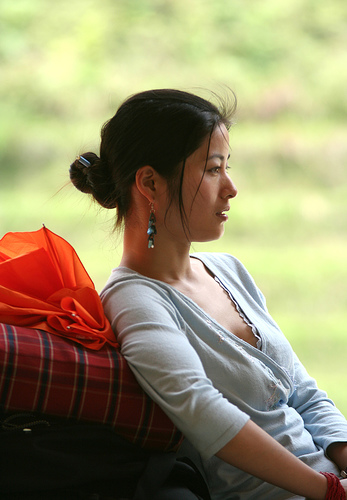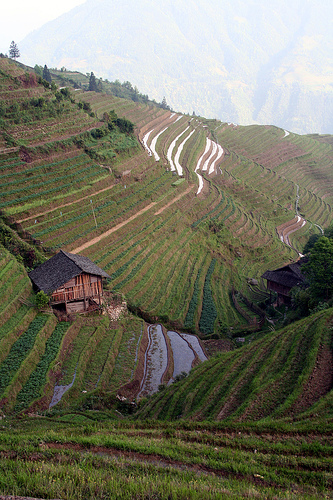Check out our Top Rewards Cards to boost your points earning and travel more!
Professor Peter Conn continues his teaching romp through China. Check out parts 1, 2, and 3.
Miao Village
We spent an afternoon and overnight at the largest Miao community in China. (The Miao are the largest or – depending on which source you consult – second-largest ethnic group in mainly-Han China.) Several thousand souls live here, in over one thousand houses. The architecture is distinctive: four-story wooden buildings raised up on stilts, marching in rows up the steep hillsides of two mountains. Here too the pressures of modernity are visible everywhere: the newer houses are fully equipped with household appliances (satellite dishes discreetly not-quite-concealed), and the small shops are managed mainly by Han on license from Miao owners (this on the testimony of a couple of shopkeepers we spoke to). The picturesque has morphed into the profit making (and good for them, say I).
Dazzling view over the two mountains from the vantage of a third, especially after dark, when the residents are obliged to keep a light burning in each window. (One of the costs of living inside a famous tourist site.)
To burnish my reputation as an appreciative guest, I sat through the 45-minute performance of Miao songs and dances, a bravura and very loud demonstration of ersatz tradition and egregious taste. I expected bad, but it was worse.
Our lodgings were somewhat rudimentary. A note here on the ubiquitous Chinese squat toilet. Those of you who have not had the experience will correctly imagine how it works: a hole in the porcelain floor of the w.c., and bring your own paper. Those who have enjoyed this sanitary treat may use this time to reminisce.
Quinshui River
Some miles from the Miao village we took a boat up the meandering Quinshui River, passing through heavily wooded and generally unspoiled country. When we arrived at the little inn where we would lunch, we were met at the shoreline by a Mama water buffalo and her quite irresistible baby boy. Your intrepid correspondent left the others and went over to introduce himself. The baby divided his time between bumping his Mama to suckle and looking quizzically at me. Finally, I persuaded him to come over for a chat and a bit of stroking. After a delightful sixty seconds or so, Mama – a quite large creature with formidable horns – decided enough was enough. She rather abruptly bolted in my direction, snorting and shaking those redoubtable horns. Did I stare her down? Did I manfully take that buffalo by the horns? You can bet I did not: my name is Chicken, as you will recall from an earlier report. Nonetheless, I did stand my ground for a few more minutes, cajoling Junior into my space for a tickle and pat, then diving out of Mama’s way, then repeat. Then lunch.
I will bring back photos, taken by an amused member of our party, of both the patting and the diving.
Just a few yards below our inn, the river is crossed by a new bridge, a narrow 175 yards (my pace is quite precise) of wooden planks suspended by steel cables. The contract is carved into stone at one end of the bridge. Like many smaller projects in China today, this one was funded by the district, not the provincial or central government. The contract specifies exactly how much sand and steel the district provided, and how much free labor the village had to contribute.
The corresponding slab of stone on the other side of the bridge spells out rules for use. No animals over a certain weight; animals must be kept at least twenty meters apart; animals may not be whipped. This last is not a humanitarian gesture, but an attempt to avoid water buffalo and other large critters bolting and giving the bridge a dangerous shaking.
On the final day of the intersession, our university hosts took us out for breakfast in one of Guiyan’s fanciest restaurants. Acres of marble, glittering chandeliers, a gallery of aquaria housing the fish or lobsters waiting their turn to become someone’s meal. But, as is so often the case, a Potemkin Village. Take another look: several of the fish in those tanks are dead. The marble is crackly in a few places. The chandelier sags lopsidedly. The staff is surly and slow: table service with Chinese characteristics, one of my waggish Chinese colleagues called it.
Like fake Apple stores and Omega watches and Louis Vuitton bags, the restaurant has copied the look of a high-end Western eatery without much idea what to do after that.
Following our excruciating meal, a visit to the famous monkey mountain on the edge of Guiyang. The name does not refer to the mountain’s shape, nor to some local legend. Instead, the entire mountain is alive with free-ranging monkeys, of a species distinctive to this region. Hundreds of monkeys, perhaps thousands of monkeys, the largest about the size of a three-year-old child, the smallest tiny babies clinging to their mothers. Monkeys underfoot, in the trees, on the paths, and quite aggressive into the bargain. They routinely snatch food and bottles from the climbers, and snarl toothfully if offended. Injuries are reported, I am told, at about the rate of one a month – most caused by teenage boys who insist on teasing the animals and pay for it.
I will admit that the whole surreal scene made me a bit nervous, but I climbed to the top, where a splendid tea awaited, complete with piba music and stunning views. Rather than walk back down through Monkey Alley, I chose a cable car. As my cabin descended, I tried not to think about those Chinese trains.
Text by Peter Conn © 2011, all rights reserved, reprinted with permission. Reference hyperlinks and images selected by The Rapid Traveler, images licensed under Creative Commons.
Check Out Our: Top Rewards Cards ¦ Newsletter ¦ Twitter ¦ Facebook ¦ Instagram


